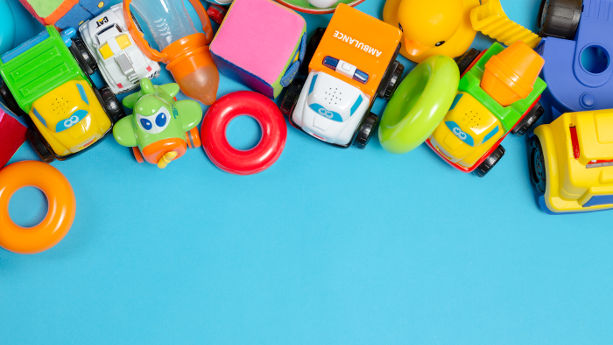
Toys and other children’s products are subject to small parts restrictions in the United States. The specific small parts requirements depend on the product type and age group but can range from bans to mandatory warning labeling.
In this guide, we explain what manufacturers and importers must know about rules concerning small parts in the US, with a focus on 16 CFR Part 1500, 16 CFR Part 1501, CPSIA, and ASTM F963.
More specifically, the guide covers small parts definitions, age group-specific requirements, warning labels, and more.

FREE CONSULTATION CALL (US, EU & UK)
According to the Consumer Product Safety Commission (CPSC), small parts and products with small parts intended for children under 3 years of age are subject to the small parts ban.
Additionally, small parts – or products containing small parts – meant for children aged between 3 to 8 years must carry warning labels.
16 CFR Part 1501 prohibits the sale of toys and products containing small parts that are meant for children under 3 years of age because these products can cause choking, breathing, or ingestion hazards to very young children due to:
a. The product being too small; or
b. A small part or component breaking off during normal use.
Here are some examples of products covered by the small parts ban:
16 CFR Part 1500 sets hazard and warning labelling requirements for specific products meant for children aged 3-6 and are or contain small parts.
You can find warning examples in the section Small part warning text examples below.
16 CFR Part 1500 also sets warning requirements for small balls and marbles that are meant for children that are between 3 and 8 years old.
Finally, this part sets warning requirements for latex balloons that are meant for children that are 8-12 years old.
The CPSC page on the small parts ban defines a “small part” as any item, in its entirety, that can fit into the small parts cylinder indicated in 16 CFR Part 15091.4. This test cylinder is approximately the size of a child’s expanded throat.
Small parts might be:
16 CFR Part 1501 bans toys and other children’s products containing small parts that are intended for children under the age of 3 because those products and their associated small parts can cause choking, breathing, and ingestion hazards.
16 CFR Part 1501 specifies numerous types of small toy-like products, or articles containing small parts, that are classified as a “banned hazardous substance”. Here are several examples of such products:
16 CFR Part 1501 specifically exempts the following products:
Note that rattles are subject to 16 CFR Part 1510, which sets physical requirements to avoid choking and suffocation risks.
Additionally, pacifiers are subject to 16 CFR Part 1511, which sets small parts test requirements.

Per 16 CFR Part 1500, certain children’s products that either are or contain, small parts or objects that present similar risks must carry labels that warn consumers about the potential dangers of buying them for young children aged between 3 and 8 years.
Here is a list of products that require small part warnings:
According to 16 CFR Part 1500.19, the above products must carry certain warning or cautionary statements that are accompanied by:
The CPSC sets criteria that can be used to evaluate which age group a product can belong to. You can find the criteria in “Table 2. Definitions and Evaluation Criteria” of the CPSC’s Age Determination Guidelines.
These criteria include:
The CPSC summarizes the criteria for products into specific age group classes, as listed below:
Here are several examples of product types, their descriptions, and their criteria for children aged from 0 through 3 years of age:
Here we list the age groups, descriptions, and criteria for some products intended for children aged 3–6 years.
16 CFR Parts 1500.19 and 1500.20 specify the labeling and advertising requirements for products that contain small parts, or similar objects.
Here are the warnings that we could find in 1500.19:
WARNING: CHOKING HAZARD — Small parts. Not for children under 3 yrs.
WARNING: CHOKING HAZARD — Children under 8 yrs. can choke or suffocate on uninflated or broken balloons. Adult supervision required.
Keep uninflated balloons from children.
Discard broken balloons at once.
WARNING: CHOKING HAZARD — This toy is a small ball. Not for children under 3 yrs.
WARNING: CHOKING HAZARD — Toy contains a small ball. Not for children under 3 yrs.
WARNING: CHOKING HAZARD — This toy is a marble. Not for children under 3 yrs.
WARNING: CHOKING HAZARD — Toy contains a marble. Not for children under 3 yrs.
ASTM F963 sets requirements for small objects in section 4.6. The ASTM F963 page on www.astm.org does not go into details on this matter. However, we found that the CPSC’s Toy Safety Business Guidance provides an example of these requirements.
Specifically, it states that mouth-actuated toys for children younger than 3 years should not release loose components when tested according to the requirements of section 4.6, and should comply with 16 CFR part 1501.
According to 16 CFR Part 1500.19, the cautionary or warning labeling statements must appear on the principal display panel of the immediate container and, if necessary, on any other container or wrapper.
Test laboratories should use the small parts cylinder per 16 CFR Part 1501.4 to determine whether a component in toys or children’s articles is qualified as being or containing “small parts”, that is a cylinder 2.25 inches long and 1.25 inches wide.
This dimension is calculated from the approximate measure of a fully-expanded throat of a child under the age of three. Small parts that fit completely into this cylinder have a high risk of choking and suffocating children of this age group, and thus do not pass the test.
Also, 16 CFR 1500.51 and 16 CFR 1500.52 contain test procedures to simulate the use and abuse of children within 0-18 months of age, and within 18-36 months of age respectively. The reason is that, in order to pass the test, the product being tested should not be easy for children to break into small parts.
Note that ASTM F963 – Standard Consumer Safety Specification for Toy Safety refers to the same test methods.
Amazon’s Seller Central page on CPSIA Choking Hazard Warnings and Material Content Limits provides the same cautionary statements, or choking hazard warnings for small parts, small balls, and products containing small balls, as the ones listed in 16 CFR Part 1500.19.
While labeling your products with the relevant warning statement, you must either indicate that the product “contains” a small ball or marble, or “is” a small ball or marble. This is so you avoid confusing the consumer.
First, never assume that your manufacturer in Asia (or anywhere else for that matter) is even remotely aware of the small parts rules under the CPSIA. As an importer, it’s up to you to assess if your product falls within the relevant age group spans – and determine if your product contains small parts or not. This is the case regardless of whether you sell OEM or ODM products.
When it comes to labeling, it’s essential to provide ready-to-print files to the suppliers in the correct file formats. Asking your supplier to ‘print small parts warning labels’ is highly risky as they can easily misunderstand or fail to create a compliant label.
In addition to the file, you should also provide the following information:


Disclaimer: The Site cannot and does not contain legal advice. The legal information is provided for general informational and educational purposes only and is not a substitute for professional advice. Accordingly, before taking any actions based upon such information, we encourage you to consult with the appropriate professionals. We do not provide any kind of legal advice. THE USE OR RELIANCE OF ANY INFORMATION CONTAINED ON THE SITE IS SOLELY AT YOUR OWN RISK.
Sources: Our articles are written in part based on publicly available information, and our own practical experience relating to product compliance. These are some of the primary sources we use:

Ivan Malloci is a co-founder of Compliancegate.com and is based in Hong Kong. He completed his Ph.D. in Control Systems at Nancy University, during which he contributed to the development of a hot strip mill control system for ArcelorMittal. See Full Bio.
Maggie February 21, 2023 at 10:55 pm Hello, It is obvious that chocking hazard needs to be legible, visible etc.. but does it necessairily need to be placed in the front of the packaging? Or it can otherwise placed in the back of the box? Thank you.
Leave a Reply Cancel reply
Create a Compliance Requirements List
Find relevant EU & US certification, labeling & testing requirements in less than 2 minutes.